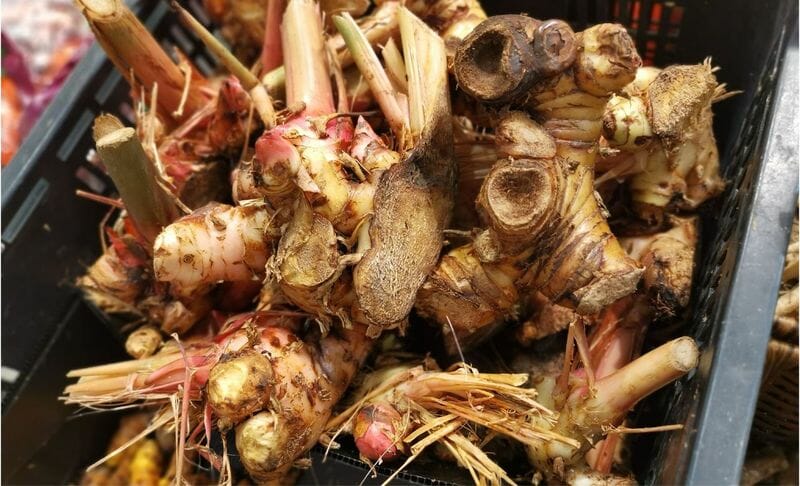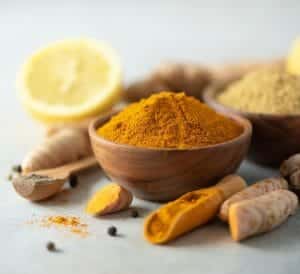
Alpinia galangal or Mahabhari Vacha, commonly known as galangal, is a rhizomatous herbaceous plant that belongs to the Zingiberaceae family, the same family as ginger. Native to Southeast Asia, galangal has been used for several centuries in traditional medicine and culinary practices. It is known for its unique flavor and many health benefits. [1]
Vacha possesses a wide range of beneficial properties, including its emetic quality, capacity to stimulate digestive fire (Vanhikara), ability to cleanse waste materials (Mala Vishodhan), promotion of urine clearance (Mutra Vishodhana), alleviation of excess kapha (Kaphaghana), relief of Vata-related issues (Vataghna), antimicrobial and disinfectant properties (Jantughna), throat-soothing effects (Kanthya), enhancement of intellectual faculties (Medhya), anthelmintic action (Krimighna), life-promoting attributes (Ayushya), digestive aid (Amapachaka), aphrodisiac potential (Vrishya), voice-improving qualities (Swaradayaka), carminative effects (Vatanuloman), vitality-boosting properties (Jivaniya), disinfectant abilities (Rakshoghna), appetite stimulation (Dipana), and cognition enhancement (Smritivardhak). [4]
In traditional Chinese and Thai folk medicine too this ginger-like Rhizome was widely in use around the 20th century and before. In southern China this herb was used extensively to treat a variety of health issues, such as diarrhea, diabetes, viral infections, microbial infections, stomach cramps, chest infections, sore throat, headache, nausea, fever, etc. [7] Chinese traditional medicine made use of Alpinia officinarum Hance cultivar of this medicinal herb, that was cultivated in Southeast China. The provinces of Yunnan, Guangdong, Hainan, Guangxi were the main growers. [8]
In this article, we will study the benefits, uses, potential side effects, and more related to Alpinia galangal.
Uses and Benefits of Alpinia Galanga
Alpinia galangal has a long history of medicinal use in traditional herbal medicine systems, including Ayurveda and traditional Chinese medicine. Regular consumption of Vacha is associated with Rasayan properties, which contribute to improved cognitive abilities and a melodious voice. Vacha’s essential oil possesses antispasmodic and carminative qualities, making it valuable in addressing conditions like epilepsy, mental disorders, chronic diarrhea, dysentery, and bronchial asthma. Additionally, Vacha is employed in the management of remittent fevers and is highly regarded for its insect-repellent properties, particularly against fleas. [4]
Here are some of the Alpinia galanga benefits:
1. Digestive Health
Alpinia galangal is known for its digestive properties. It can help alleviate symptoms like flatulence, dyspepsia, vomiting, and stomach sickness. [1]
2. Anti-Inflammatory Properties
The polyphenols and antioxidants in Alpinia galangal exhibit anti-inflammatory properties. They can help reduce inflammation, benefiting conditions such as arthritis and inflammatory bowel disease. [1]
3. Anti-Diabetic
Galangal contains hypoglycemic properties and shows an impact on blood glucose levels. Its extracts have exhibited a significant reduction in blood glucose levels. [2]
4. Pain Relief
Traditional medicine systems have used Alpinia galangal as a natural pain reliever. It may help alleviate and ease heart pain, including angina, heart attacks, and gallbladder attacks. Its properties, like vessel dilation and inflammation reduction, contribute to heart pain relief. [1]
5. Respiratory Health
Galanga has been used to treat respiratory issues like coughs, and colds, as well as for the treatment of tonsillitis and pharyngitis. Its anti-bacterial properties help combat respiratory infections. [1]
6. Antioxidant Properties
The potent antioxidants such as Vitamins E and C in galangal help neutralize free radicals in the body. The flavonoid content exhibits b anti-cancer effects and protection against carcinogenicity from overcooked or char-grilled foods. It also preserves the endogenous free radical scavenger glutathione, further enhancing its anti-carcinogenic potential. [1]
7. Antimicrobial Effects
Alpinia galangal contains compounds with antimicrobial properties. These properties can help combat various types of bacteria and fungi, making it effective in treating colic, dysentery, food poisoning and skin disease. [2]
8. Skin Health
Galangal or Mahabhari Vacha is used topically for its benefits to the skin. The paste of these rhizomes are given with the paste of Curcuma aromatica rhizomes and Azadirachta indica leaves to treat conditions like eczema or applied with the seed paste of Argemone Mexicana for other skin conditions. [3]
9. Cold, Cough, and Fever
Mahabhari Vacha is also taken with other ingredients like Calonyction muricutum flower pedicles, Ipomoea muricata seeds, Senna leaves, Cassia fistula fruits pulp, with black pepper, and consumed with lukewarm water to treat cold, cough, and fever. [3]
Side Effects
Based on research findings, there have been no reported harmful effects associated with the use of Alpinia galangal.
FAQs
• Can Alpinia galangal work as antibiotics?
Yes, the root of Alpinia galangal generates 3-methylcarbazoles, a significant anti-inflammatory compound that effectively inhibits the production of inflammatory mediators. Most endophytic bacteria are known for their production of various types of antibiotics. [5]
• What is the best way to enjoy the antimicrobial effect of galangal?
The combined extracts of Kulanjan (Alpinia galanga), rosemary (Rosmarinus officinalis), and lemon ironbark (Eucalyptus staigerana) exhibit a mutually reinforcing antimicrobial effect. [6]
• What are the alternate names for kulanjan?
This plant is known as Sitharathai (Chitharathai) in Tamil, referred to as Lesser Galangal in English, and called Kulanjan in Hindi. Sitharathai’s scientific name is Alpinia Officinarum. [6]
Conclusion
Alpinia galangal, or galangal, is a versatile herb with a long history of culinary and medicinal uses. It offers many health benefits, from aiding digestion to relieving inflammation and pain. Whether you enjoy its unique flavor in dishes or explore its potential as a natural remedy, galangal remains a valuable plant in our pursuit of holistic well-being.
Disclaimer:
This article is written from a health and wellness perspective and is not medical advice. Kindly seek the help of a certified medical practitioner before initiating any treatment.
References

















11 Comments